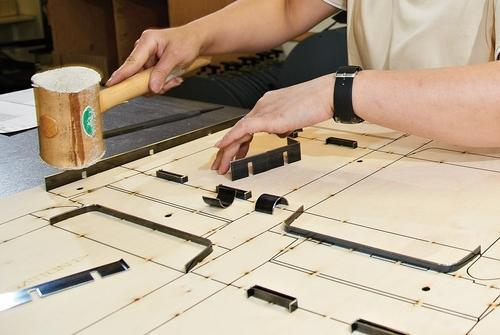7 Materials to Work with Using Die Making Accessories

Is die-cutting on your mind?Bet you are thinking about paper.
Good call, but there are so many other options to go in the first place. Not only can you plain die-cut them, but also give them just about any shape you like. Right from a school project for art classes to any DIY type for your home decor, choosing the right kind of die-making accessories is the essence here. And guess what! Things aren’t just limited to using old stock cards and stuff. This is all about exploring the entire gamut of die-making accessories to breathe life into your project.
In this post, we will take you through seven such materials to work with using die-making accessories.
1. Vellum
If you are looking to explore the world of die-cutting accessories, you will need to know about vellum.
Vellum is nothing but a paper product. It’s more on the translucent side resembling parchment paper that was earlier made using animal skins. In today’s era, however, things have been replaced by paper pulp.
Vellum is a wonderful option for anyone looking to work with heavy papers that are also opaque but manage to pack in softer edges too, which makes die-cutting a delightful affair. Nevertheless, here are a couple of pointers to keep in mind when working with vellum:
- Always make sure you are not cutting it roughly, as that can show the adhesive right through the paper itself.
- Also, you will need to stitch vellum die cuts by using special adhesives. Essentially, you will have to work in layers to achieve the desired defect.
2. Felt
Wonderful as it gets, Felt is another great option among the most sought-after die-making accessories.
For newbies, felt is uniquely prepared by pressing and condensing fibers, and this is precisely one thing that makes Felt an excellent option for die-cutting. Moreover, it doesn’t tear, doesn’t unravel, cuts easily in a manual machine, and to top it all off, it has this all-good matte appearance that never fails to impress.
Pro tip: Just keep things smooth, and when cutting, don’t pull felt too hard as it might get twisted.
3. Foam Die-Cut
Looking for a worthy option for die-making accessories that kids can handle? Foam die cuts should be at the top of your list.
Nevertheless, foams aren’t just meant for kids, adults too can have fun playing with foam die cuts. And that’s the beauty of this material as it makes ordinary things pop out.
For anyone looking to create their stamp, foam die-cuts can be a good choice too. After your desired foam cut, all you have to do is glue them further to acrylic blocks, and voila! You’re done!
4. Vinyl
The magic of Vinyl is largely observed when working with digital die-cutting machines. However, one must not ignore its potential to work on manual systems too.
Vinyl is a highly flexible material that finds its way across a plethora of home decor projects like wall accents, stickers, showpieces, and a lot more. One of the plus points of using vinyl is its adhesive backing which makes sticking and pasting an effortless affair.
For anyone wanting to explore off-beat die-making accessories, Vinyl should invariably be a worthy option to consider.
5. Foiled Papers
A sheer piece of delight as a make-material for all fashion enthusiasts, foiled papers are all about glitz and glamor.
These days, metallic choices like gold and silver are ruling the charts, especially for parties and weddings alike. However, that doesn’t mean foiled papers are a new entrant on the block. The use of foiled pacers using die-cutting accessories has been for quite some time now, but it’s only now that its demand is being felt.
And there are plenty of reasons why. It’s outright gorgeous and takes on another layer of shine when die cut. However, working with foiled papers demands one to be extra careful to keep it safe from scratching the surface when cutting into desired shapes and even more when using adhesives on the back. If you aren’t paying attention, you might just end up with glue on the shiny surface, which is sure to mess up the whole scenario.
6. Stock Cards
When you put together a list of the best materials to work with using die-making accessories, the classic ones demand a mention. Generally, the stock cards are quite heavy and use a matte finish in a rainbow of colors.
These stock cards are usually categorized between fifty and hundred-pound paper. Now, here’s the rule of the thumb, the heavier paper you opt for, the better the quality. Also, a heavier paper will generally have more binding and holding capacity.
7. Fabrics
If you have been looking to explore a wholesome range using fabrics for die-making accessories, you’ve got to try woven fabrics. From denim to silks, cotton to canvases, burlaps, and twills, you have a lot of choices.
Remember, if you are looking for easy cuts, go for lighter fabrics.
However, if you want to work with fabrics like denim and all, you might want to use steel dies. For first-timers, stretching can be an issue, and to make life easy, it is recommended to iron the fabric on the reverse side.
Wrap Up
Working with die-making accessories doesn’t have to be difficult, at least now when you know the best materials to work with. So, go on, make the most out of your die-cutting skills like you always wanted.
Have fun!



